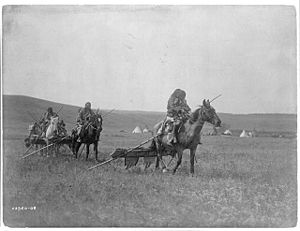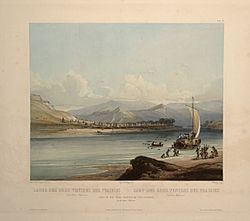Gros Ventre facts for kids
|
Assiniboin Boy, a Gros Ventre man, photo by Edward S. Curtis
|
|
| Total population | |
|---|---|
| 3,682 (2000 census) | |
| Regions with significant populations | |
| Languages | |
| English, Gros Ventre | |
| Religion | |
| Roman Catholicism, Sun Sun Dance, traditional religion | |
| Related ethnic groups | |
| Arapaho, Cheyenne |
The Gros Ventre (pronounced GROH vont), also known as the Aaniiih, A'aninin, or Haaninin, are a Native American tribe. They speak an Algonquian language. Today, most Gros Ventre people live in north central Montana.
They are part of the Fort Belknap Indian Community of the Fort Belknap Reservation of Montana. This is a group of tribes officially recognized by the U.S. government. The community includes the Gros Ventre and the Assiniboine people. The Fort Belknap Reservation is located in northern Montana, near the town of Harlem.
Contents
What's in a Name?
The Gros Ventre people call themselves ʔɔʔɔɔ̋ɔ́niinénnɔh. This name means "White Clay People." You might also see it written as A'aninin, Aaniiih, or Haaninin.
The name Gros Ventre was given to them by the French. It means "big belly" in French. This name was a mistake. The French misunderstood their sign language. The Gros Ventre were sometimes called the Gros Ventres of the Prairies. Another tribe, the Hidatsa, were called the Gros Ventres of the Missouri.
The Piegan Blackfeet tribe were often enemies of the Gros Ventre. They called the Aaniiih Piik-siik-sii-naa, which means "snakes." Today, the Piegan Blackfeet call them Assinee, meaning "big bellies." This is similar to the French name. Another name, Atsina, might mean "gut people" or "like a Cree."
The Arapaho people are related to the Gros Ventre. They called them Hitúnĕna, which means "beggars." This name also has other meanings, like "hunger" or "waterfall."
A Look at History
Historians believe the Gros Ventre lived near the western Great Lakes region about 3,000 years ago. There, they grew crops like maize (corn). They were once part of a larger group with the ancestors of the Arapaho tribe. This group lived along the Red River Valley in what is now Minnesota and Manitoba, Canada. They were also close with the ancestors of the Cheyenne tribe.
The Gros Ventre spoke the Gros Ventre language (Atsina). This language is similar to the Arapaho language. Sadly, very few people speak it today.
The 1700s
In the early 1700s, the large tribe split into two groups: the Gros Ventre and the Arapaho. These tribes, along with the Cheyenne, were some of the last to move into Montana. They moved because other tribes, like the Ojibwe, pushed them westward. After reaching Montana, the Arapaho moved south to Wyoming and Colorado. The Cheyenne also moved on.
By the mid-1700s, the Gros Ventre had horses. This changed how they hunted and traveled. The first time settlers met the Gros Ventre was around 1754. This meeting happened near the forks of the Saskatchewan River.
A terrible disease, smallpox, greatly reduced their numbers around this time. Around 1793, the Gros Ventre burned two trading posts. These posts belonged to the Hudson's Bay Company. They were giving guns to the Cree and Assiniboine tribes, who were attacking the Gros Ventre.
The 1800s
In 1832, a German explorer named Prince Maximilian of Wied-Neuwied met the Gros Ventre. He was with the artist Karl Bodmer. They drew pictures and wrote about their meeting near the Missouri River in Montana.
The Gros Ventre later joined the Blackfoot Confederacy. After this alliance, they moved to north-central Montana and southern Canada. In 1855, Governor Isaac Stevens signed a treaty with several tribes. This treaty aimed to bring peace between the United States and the Blackfoot, Flathead, and Nez Perce tribes. The Gros Ventre signed as part of the Blackfoot Confederacy.
Their land near the Three Fork area became a shared hunting ground. Other tribes like the Flathead, Nez Perce, Kootenai, and Crow also used it. In 1861, the Gros Ventre left the Blackfoot Confederacy.
The Gros Ventre then allied with the Crow tribe. They fought against the Blackfoot but were defeated in 1867.
In 1868, the U.S. government built a trading post called Fort Browning. It was for the Gros Ventre and Assiniboine tribes. But it was on land often used by the Sioux, so it was closed in 1871. Then, Fort Belknap was built. This new fort was a place for trading and for the tribes to receive supplies.
In 1876, the fort was closed again. The Gros Ventre and Assiniboine were told to go to other agencies. The Assiniboine agreed, but the Gros Ventre refused. They did not want to go to a place where they might meet the Sioux, who were their enemies. They chose not to receive supplies rather than move. In 1878, Fort Belknap Agency was reopened. The Gros Ventre and Assiniboine could get their supplies there again.
White Eagle, an important Gros Ventre Chief, passed away on February 9, 1881. He died near the Judith River.

In 1884, gold was found in the Little Rocky Mountains. Miners and mining companies wanted the land. This led to the tribes giving up parts of the mountains in 1885.
Jesuits came to Fort Belknap in 1862. They worked to convert the Gros Ventre people to Roman Catholicism. In 1887, St. Paul's Mission was built near the Little Rocky Mountains. Many traditional ceremonies were lost over time after the mission was established. However, two sacred pipes, The Feathered Pipe and The Flat Pipe, are still very important to the Gros Ventre's spiritual beliefs.
In 1888, the Fort Belknap Indian Reservation was created. The Blackfoot, Gros Ventre, and Assiniboine tribes agreed to live on three smaller reservations. These are now known as the Blackfoot Confederacy, the Fort Peck Indian Reservation, and the Fort Belknap Indian Reservation. Fort Belknap was named after William W. Belknap, who was the Secretary of War.
The 1900s
By 1904, there were only 535 A'ani tribal members left. Since then, the tribe has grown. Their population has increased a lot.
The 2000s
In March 2012, 63 American bison from Yellowstone National Park were moved to the Fort Peck Indian Reservation. These bison are special because they are genetically pure. They have not been mixed with cattle. Native Americans celebrated this event. It happened over a century after bison were almost completely gone from the land. The Assiniboine and Gros Ventre tribes at the Fort Belknap Indian Reservation will also receive some of these bison.
How the Tribe is Governed
In the past, the Gros Ventre had twelve separate groups, each led by a chief. Today, the reservation has an elected council. This council includes four officers and four members from each tribe.
The Gros Ventre tribe is part of the Fort Belknap Indian Community. Their rules for government were approved in 1935. The tribal council has six elected Gros Ventre members, six elected Assiniboine members, and three appointed members.
Notable Gros Ventre People
- Theresa Lamebull (c. 1896–2007), a fluent speaker of the Gros Ventre language.
- George Horse-Capture (1937–2013), an anthropologist and author.
- James Welch (1940–2003), a Blackfoot-Gros Ventre author.
- Jamie Fox, a Métis fiddler.
See also
 In Spanish: Gros ventres para niños
In Spanish: Gros ventres para niños



